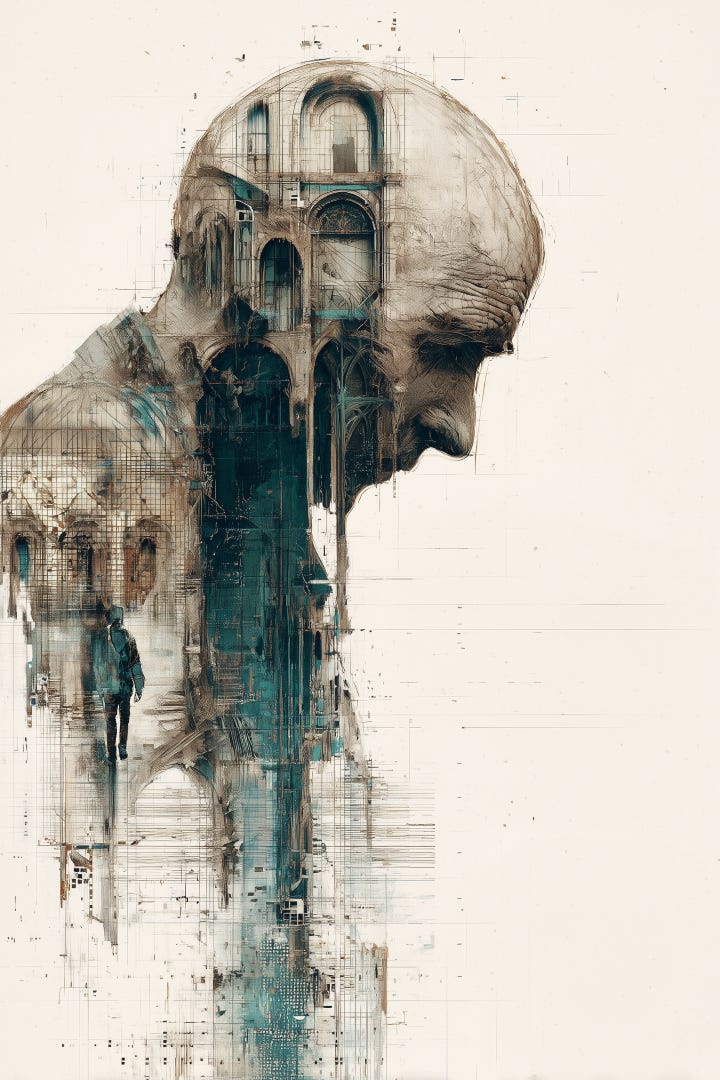Inheriting Presence
A 19th-century hotel in Saigon, and the ghostly avatars that will linger long after we’re gone
I’m sitting in the Hotel Continental Saigon where Graham Greene (1904 - 1991) wrote the novel The Quiet American in 1955. The movie also was filmed here. I rewatched the movie, the Michael Caine version, last night in this room. Of course, the novel is better. Greene’s prose is among the best in the English language. The Heart of the Matter is one of the novels that I have reread most often.
The hotel was established in 1880; that’s 145 years ago. The place has been updated a bit but still carries a lot of French colonial vibes. A plaque celebrates the hand-carved grand staircase. Yet, we all know the dark history of French colonialism in Vietnam and the decades of war that followed. Choices made more than a century ago reverberate through time. We live in choices made by others.
Ordinary life goes on outside. Across the street, stylish young Vietnamese women pose for photos in front of the Opera house. Presence lingers. Someday, their grandchildren will find those digital portraits, snapshots of a life.
Graham Greene likely sat many days at a table on the veranda of the hotel overlooking the Opera house. In the movie, a violent scene of explosions takes place on the very spot that is now an Instagram hotspot. Greene died in 1991 but his framing of place, conflict, and morality continue to influence conversations he never foresaw.
This hotel: a century and a half, 150 years: it’s not an abstraction. Many places in the world, particularly here in Vietnam, are witnesses to the lived reality of a turbulent, transformative time.
The Saigon that Greene experienced is not today’s Ho Chi Minh City, which now (through governmental redistricting) stretches 100km to the South China Sea. In the 70 years since Greene wrote The Quiet American in this hotel: wars came and ended, the city was renamed, the nation remade. 150 years is transformation stacked upon transformation.
If a hotel can last 150 years, if a novel can still shape thought decades after its author’s death, then what about us? What about the digital traces we leave behind? What about the ghostly avatars of ourselves that may linger in classrooms, homes, and public spaces long after we’re gone?
Responsibility Horizon
Last year, when I was teaching an undergraduate course on Responsible AI, I asked a simple question: how far into the future are we responsible?
At first, the answers clustered around the immediate: years, maybe decades, centuries. Then the conversation shifted toward family and the children that my students might have someday. I didn’t have a child until later in life, at age 45. For many years, I thought I would never have a child but I always recognized a responsibility for the next generation.
My students started to think not only about the lives of their future children, but the children of their children, the grandchildren of today’s college students. My students came to the point that the most concrete measure of the future is not abstract centuries, but the lives of their own grandchildren.
Let’s do the math. Assume that a 20-year-old college student today was born in 2005. Some will have children earlier or later, but let’s assume in ten years, age 30, that they will start a family with their first child born in 2035. And that child will have a child thirty years later in 2065. The child born in 2065 would be the grandchild of today’s college student. With advances in healthcare and longevity, that grandchild might live more than 90 years to around the year 2155. That’s 130 years from now. Adjust for various lifespans and years of birth and longevity, and we’re easily looking at a time horizon that the grandchild of today’s college student could be alive 150 years from now: the year 2175.
150 years. Not infinite time, not eternity, but a human horizon, the span of this moment today to the lifetime of a yet unborn grandchild.
This span of 150 years, using the frame of a grandchild’s life, makes responsibility felt. Our responsibility is not for strangers, but for our descendants, for the descendants of today’s youth.
If my students’ grandchildren are going to live with the traces of what we build, then we cannot measure responsibility by the length of a funding cycle, a product roadmap, or even our own lifespans. The horizon stretches 150 years. The challenge: how do we build with that future in mind?
What does that mean in practice? I’m trying to imagine my students’ grandchildren, logging into a class and finding me there: not in the flesh, but as a lifelike avatar, stitched together from today’s words, code, and videos.
Imagine if you can leave a lifelike avatar for your own grandchildren and great-grandchildren?
Ghosts in the Data
There are legitimate questions as to whether it’s even desirable for lifelike versions of ourselves to persist beyond us. But, undoubtedly, many will choose to leave a virtual legacy for the future. Like Greene’s novels, my avatar might still speak long after I am gone. But unlike Greene, my presence would be interactive, persuasive, and unbounded in reach. The question is not whether such ghosts will exist, but whether we can design them to guide rather than mislead, to bear wisdom rather than distortion.
Graham Greene, if he were writing in our century, might have given such a story a title like The Human Error: the tragedy not of machines gone rogue, but of humans failing to anticipate how their voices, their biases, their ghosts would echo far beyond their own lifetimes.
Writers know that they are writing for a future generation. But I often get the impression that business people know that their business is likely not to exist beyond their own lifetime. Not all businesses are made to last forever. They are made to make a profit and secure a financial foundation (often through being acquired) for the founders, their families, and investors. That’s why avatars must be built around open standards that surpass the control and limits of any one company.
Let’s enter the classroom of the future. (I use the word classroom, though I think it’s highly unlikely that the type of educational environment I’m about to describe will happen in a physical room filled with students.) Imagine the year 2098. A group of students situated anywhere in the world logs into a class. Their teacher materializes as a lifelike avatar of myself: stitched together from the posts, code, and videos I left behind in the early 21st century. (This thought horrifies me; I really need to up my game if my presence is going to linger around.)
An easy critique of this argument is that there’s no way we can know what 2098 will be like. We barely have an idea what 2028 will be like. So, let’s ignore the long-term and focus on building the present, the next few years. But building the present is building a presence that lingers year-by-year.
The avatar speaks with confidence, even when wrong. (Many professors, and most politicians, already do that.) This avatar (let’s just call it Professor) carries my voice, my mannerisms, my blind spots. To those students, the Professor feels present, alive, authoritative. But it is also a ghost trained on a version of me that never had the chance to answer their questions, adapt to their world, or learn from their mistakes.
What, then, should we be doing now to account for such ghosts trained on versions of ourselves that never had the chance to answer future questions, adapt to future worlds, or learn from future mistakes?
Perhaps one response is contextualization.
We often read literary texts, like Greene’s The Quiet American, with introductions and footnotes that remind us of the era in which it was written. Perhaps our digital presences need something similar: layers of metadata and framing so that no one mistakes these avatars for timeless oracles.
Design for Contextualization
But what happens when our digital ghosts speak without footnotes? An avatar trained on my words might answer a question in 2098 with total conviction. Yet the answer would be grounded in assumptions from 2025, a time of very different debates, blind spots, and horizons of knowledge. To a future student, though, the avatar’s confidence might look like authority.
If books require footnotes, perhaps avatars require overlays: metadata that marks the time and place of their training; caveats that declare what they could not know; context that helps future audiences interpret rather than simply absorb. Without this, digital presences risk becoming timeless in the worst way: voices speaking as though they are universal, when in fact they are provincial, contingent, and bound to their own moment.
The ethical design question: how do we embed annotations into presence itself? Not just for scholars, but for anyone who will live with the legacies of our voices long after we are gone.
Another response is impermanence. A hotel might stand for more than a century, but a digital avatar could be designed with off-ramps: expiration dates, kill-switches, or archival transitions. Not all businesses are started to last forever. Not everything we create should speak forever.
Build Sunset Clauses & Off-Ramps
The Continental Saigon has lasted 145 years, but that is precisely the problem. Its persistence is not neutral; it carries the architecture of colonialism into the present. Digital presences may prove even more enduring, but unlike physical structures, avatars can replicate infinitely and seep into every corner of daily life. If left unchecked, these digital voices may speak forever with a confidence unmoored from reality.
That is why we must ask: should every presence persist?
In most of our infrastructures, we already accept the necessity of endings. Bridges have lifespans. Medications expire. Hotels need renovating. (You better change those mattresses often.) We plan for renewal, revision, or retirement. Yet when it comes to digital avatars and AI systems, permanence is often treated as the default with immortality coded in by design.
What would it mean to embed off-ramps? To give our avatars expiration dates, graceful shutdowns, or archival transitions that allow them to persist as history but not as authority? Could an avatar be designed to “retire” after 50 or 100 years, shifting from a living presence to a documented artifact? Is this a new job for librarians: the avatar archivist?
The ethical horizon of 150 years demands humility: not everything we create should endure. Some presences should end. The challenge is deciding not only when but also how, so that the traces we leave are inherited as history.
Equally important is documentation. An avatar built from today’s words and code will carry today’s blind spots. We can begin to name those limits now by recording not only what we know, but what we don’t, and what we suspect we may have wrong. But nobody likes writing documentation. How can generative AI embed the needed documentation into the metadata that resides with our avatars?
Document Bias and Limits
Every voice is partial. Greene’s The Quiet American was not a neutral account of Vietnam; it was steeped in his perspective, his disillusionment, his politics, his religion. Today, scholars and readers approach it with that in mind. The text carries his bias, but we can locate it, contextualize it, and argue with it.
An avatar, however, carries bias in a different form. Trained on a finite body of words, code, and images, it speaks as though that slice of a life were the whole truth.
If we accept that these avatars will exist, then one responsibility we bear now is to make our partiality visible. This means documenting not just the content we produce but also its conditions: what sources we relied on, what perspectives we ignored, what we misunderstood. It means recording our doubts alongside our convictions, so that future interpreters have more to work with than a seamless illusion of certainty. Who is going to do that work?
Imagine if every avatar carried with it a ledger of limits, a record of the assumptions baked into its training. Future generations could treat our digital ghosts not as oracles, but as situated voices.
To acknowledge bias is not to weaken presence. It is to leave behind a trace that is more honest, more interpretable, and ultimately more humane.
There is also the matter of governance. The decision to keep or retire an avatar should not belong only to the individual or to the companies that host them. We may need intergenerational mechanisms (trusts, councils, or institutions) that can audit and curate the presences that persist.
Intergenerational Governance
Who decides which presences persist? With books, there are editors, publishers, and libraries. But those are gatekeepers whose presence is increasingly shown to be unneeded. With monuments, there are city councils and preservation boards. But those can be weaponized for political ends. Even bridges and buildings are inspected, regulated, and often torn down and replaced with something more appropriate for the era. Is presence ever left entirely to chance?
Our digital avatars risk slipping through those filters. Once created, how do we prevent these avatars from being copied endlessly, hosted anywhere, and repurposed without oversight? My students’ grandchildren may not just inherit one version of me: they may inherit dozens, some faithful, some distorted, all speaking with authority I never authorized.
This is not only a technical question; it is a political one. Who has the right to retire a ghost? Who can audit its accuracy, revoke its license, or determine whether it is still fit to speak? If we leave those decisions solely to corporations, the answer will be guided by profit. If we leave them to the dead, the answer will be silence.
We may need new forms of governance that look forward across generations rather than back to individual rights. Imagine an intergenerational trust that holds digital legacies in stewardship, auditing their use every few decades. (Yikes, that’s rather concerning.) Imagine councils charged with deciding whether an avatar still serves the living or whether it should be archived. Honestly, I don’t see how any of that bureaucracy will work in practicality without being used for political advantage to influence public opinion.
But without some mechanisms, the danger is not simply that ghosts will persist, but that these avatars will persist without care. Intergenerational governance is the recognition that responsibility cannot stop at death. It must be carried forward, not just by families, but by institutions designed to mediate between the living, the dead, and the not-yet-born.
Most of all, we need to shift the frame. The goal is not digital immortality. It is stewardship.
What we leave behind should be gifts, not debris.
Shift the Frame from Immortality to Stewardship
Behind many visions of digital legacy lies a hidden desire: immortality. The fantasy that we can keep speaking, keep teaching, keep being, long after our bodies fail. But immortality is not the same as responsibility. An avatar that never ends may not honor us; it may burden those who inherit it.
What if we stopped asking how long our presences can last, and instead asked how well they can be stewarded? Stewardship implies curation, care, and responsibility. It means pruning what no longer serves, preserving what still holds value, and handing down legacies as gifts for future generations.
In this light, the measure of a digital ghost is not its duration but its quality of care. Who tends to it, updates it, retires it, or reframes it for a world its maker could never imagine? A stewarded presence could be a guide, a companion, or a historical artifact. An un-stewarded presence could become noise, distortion, or ruin.
The ethical shift we need is simple: from the pursuit of endless life to the practice of responsible inheritance. Our task is not to outlast ourselves, but to ensure that what endures is worthy of being lived with.
The Continuum of Presence
If the Hotel Continental Saigon reminds us that colonial legacies can linger in structure, and Graham Greene that words can linger on the page, then our responsibility is to recognize that digital presences will linger in ways harder to erase.
Questions to think about:
What traces of yourself are you leaving today that could still be speaking 150 years from now?
If future generations encounter your voice, will they inherit wisdom or your blind spots amplified by confidence?
Should every digital presence be designed to persist, or do some deserve an ending?
Who gets to decide which ghosts endure: you, your descendants, corporations, or non-profits that take on archival responsibility?
When presence lingers long after intention has faded, what does responsibility really mean?
Will what we leave behind be inheritance, scar, or error?




